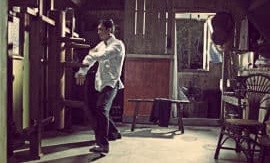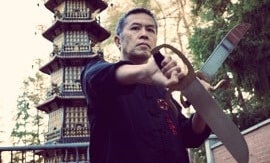
IF ANYONE DOES A SIMPLE SEARCH FOR WING CHUN, ONE WILL FIND TREMENDOUS INFORMATION AND DEMONSTRATIONS. NOW, ALTHOUGH THE VARIETY IS VAST, MOST OF THESE SYSTEMS CAN ALL BE TRACED TO A HANDFUL OF ANCESTORS.
One noted ancestor was Dr. Leung Jan, grand teacher of the famed Ip Man. In this issue, I will interview and discuss with Sifu Jim Roselando Jr., noted practitioner of Pin Sun Wing Chun and researcher of Wing Chun and Red Boat arts, about the signatures of Dr. Leung Jan’s Gung Fu and several other hot subjects found in today’s Wing Chun community.
What can you tell me about the signatures of Dr. Leung Jan’s Gung Fu?
When it comes to Dr. Leung Jan’s art of Wing Chun, there are certain signatures. Wing Chun is a soft Southern system noted for using a narrow Horse and Short Bridge. We have a strong focus on attacking our opponent’s centre while defending our own (Da Jung, Sao Jung). Chi Sau training is a famed aspect of our system, and we are noted for close-body applications and a unique type of Chuk Ging (“Shocking Force”).
Can you tell me about the training of empty-hand progression for the art of Pin Sun Wing Chun?
Due to how our system rapidly develops the body and application, Pin Sun Wing Chun is often referred to as “Wing Chun on Steroids”. The system has a core solo platform, or what we refer to as the essence of the three fist sets, which begins with pre-training and progresses through the famed “12 Hands of Leung Jan.” The 12 Hands begin with sets one to four, which cover open- and closed- fist basics. Sets five to nine focus on long- and medium- range sets that cover the straight line and over-and-under attacking angles. Sets 10-12 focus on close-body and out-to-in attacking angles. These sets give the practitioner the training, tools and dynamics needed to attack and defend all angles and ranges of combat.
Pin Sun Wing Chun is famous for its Two-Man sets and Chi Sau training. What can you tell me about this aspect of Dr. Leung Jan’s Gung Fu?
Pin Sun Wing Chun is an art rich with partner training but known for our Chi Sau. Nowadays, most systems have longer forms and minimal partner training. We have fewer forms and more partner training. Regarding the transmission of this skill, one will be taught in the same progression as the solo art. Our art begins with the longest range, which is the training of the wrist. From there, we progress to the medium range and elbow. Last, we progress to the closest range, which is the shoulder or body. These three ranges, or stages of development, are often referred to as Yat (First Hand), Yee (Second Hand) and Som (Third Hand), training the whole arm in a spiralling method covering all possible ranges and angles. A qualified teacher must intimately transmit Dr. Leung Jan’s Two-Man sets and Chi Sau to a student. In many ways, this is the heart and soul of our art.
Pin Sun Wing Chun is famous for its close-body fighting. What can you tell us about this?
Today, there’s a great deal of debates and discussions regarding Wing Chun and what is a close-body fighting system. Many think close-body is chest-to-chest, which is not the case. Equally as bad would be over-extending. In Wing Chun, we drop the shoulders and sink the elbow. The cycling or paths of motion are fine and never extreme, meaning we don’t overreach, nor do we fully collapse. Our art’s movements seal off your opponent’s attack momentarily while striking. If there is no bridge, you just strike! Fook Fu is the closest training of the Pin Sun Wing Chun art and requires the sharpest dynamics, which is why it’s the final stage of development. Although we train long, medium and close fighting methods, our longer aspects are still closer fighting actions when compared to classical Long Fist arts.
You mentioned Chuk Ging (“Shocking Force”). What is Chuk Ging and how is it cultivated?
Chuk Ging results from a specifically conditioned body, combined with specific dynamics. In Pin Sun Wing Chun, there is a direct relationship between the solo, partner, Chi Sau, Wooden Dummy, and the Long Pole. Each of these aspects conditions the body while enhancing the boxing and dynamics. The result is soft but powerful, Gung Fu, dynamic in response and shocking in its output.
There’s much discussion and debate regarding what is and isn’t Internal Wing Chun. You have done extensive research into the origins of the art. What can you tell us about this hot topic?
Regarding this debate, it is important to note that, during Dr. Leung Jan’s time and the Red Boat era, there were no Internal or External arts, so essentially all Wing Chun was Internal! We also have several quotes preserved from Dr. Leung Jan stating, your power must be Internal (Lik Yiu Noi Gong). So, there really isn’t any debate as to whether Wing Chun is or isn’t Internal. There is another element to this discussion, which started in 2007 when I wrote the first article on the Emei connection, which was the start of today’s Internal fad. Watching this evolve since that time has been interesting. Briefly, there is an old long form preserved by the Cho family. This art of Siu Lin Tao later became known as, and evolved into Wing Chun. If you analyse the Siu Lin Tao poetry, it shows a fascinating connection to the Emei 12 Zhuang art. Now, unfortunately, there is no continuity of teaching from the Red Boat era preserving any Wing Chun art as a “strict” Neigong, and nowadays, many people are trying to rebuild the system by fusing Internal concepts/principles. I recommend those who are looking for something to cross-train with any Wing Chun art study the foundation of Emei 12 Zhuang, which is the famed “Heaven” and “Earth” sets. This is pure life-nourishing Neigong without foreign habits. If Emei is our ancestor, it only seems logical.
What are your thoughts on Wing Chun regarding its effectiveness in today’s combat sports like MMA?
When evaluating any physical activity, you must start with a fair comparison of time invested. I often hear, “How come I don’t see Wing Chun in the UFC?” The average Gung Fu teacher works a nine-to-five job and teaches a few nights per week, where the competitive fighter is training multiple sessions daily. When you include fitness, diet, sparring, and other factors, one can see this is the reason most Gung Fu guys can’t compete in the UFC. Now, with that in mind, there is absolutely no reason someone who trains x-hours a week can’t practise sparring with any other practitioner training a similar schedule, but always remember, you have to be fit to fight.
Regarding the art of Pin Sun Wing Chun, can you tell us how long one should expect to train to achieve good skill?
Even though our platform is core and hits the body at a rapid pace, realistically, achieving skill does not differ from physical activity or sport. However, Pin Sun Wing Chun is a specifically conditioned body and dynamics that require time to change you physically and become a part of your natural being. Henry Mui Sifu often states, “Three, Five, Seven!” What does that mean? If someone was faithful to their solo cultivation and had regular hands-on training, they can expect to develop what my Sifu called, “Basic Requirement Power”, in three years. Sifu said, if someone was talented, they might achieve that in two years, but if someone had physical habits from another style, it would take about three years. Old habits are hard to break! Five years of faithful and specific solo cultivation and regular hands-on to achieve good skill. Seven years if one wants to achieve high skill. I can’t stress the importance of progressive solo cultivation and regular hands-on transmission. The hands-on not only provides an added element of conditioning, but it also is where one develops their connections, numerous attributes that, without regular hands-on, can’t be developed, which include our transitions and most intimately transmitted applications. Imagine learning Brazilian Jiu-Jitsu without regular mat time and grappling with an instructor. It would be impossible! Last, if someone took a crash course and learned our entire art in a few sessions, which sadly is all too common, they will have collected an art and cultivated nothing. As we say, Pin Sun frosting but no Pin Sun cake.
Any advice or final thoughts you would like to share?
The late Sifu Fung Chun stated Wing Chun is designed to stick closely to the body of our opponent, nullify their attack while counter-attacking swiftly. Sifu Fung Chun also stated the legs, arms and the whole body must be relaxed. These two pieces of advice, regardless of lineage, can sum up the core of Wing Chun, and by openly sharing and training with each other, we can strengthen the art for future generations.



















